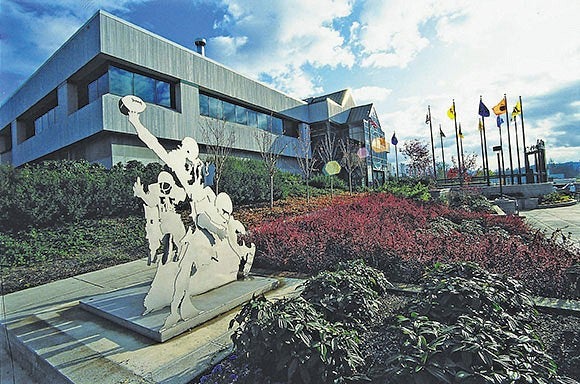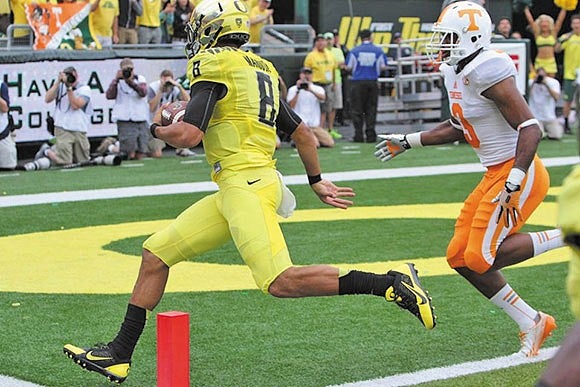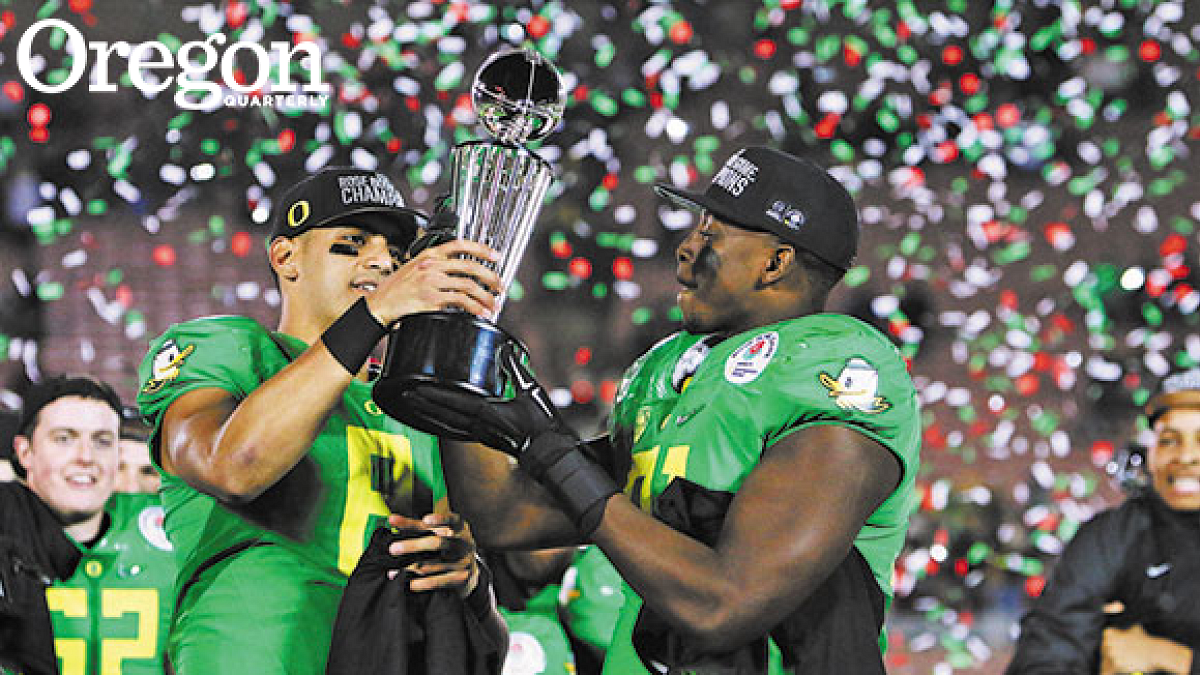It wasn’t so long ago that Ducks football was a national afterthought—a sometimes good but never great program, and one that once went 26 years without making it to a bowl game. But things are different now. Oregon has become one of the most successful programs in the country—competing for the national title twice in the past five years, while posting at least 11 wins per season. This eye-popping success on the field over the past decade follows another decade or so of slowly building the program. The Ducks have gained national notice for innovative game plans, successful marketing, impressive facilities, and their ability to attract players of a caliber that rarely came to the UO a generation ago.
So what was the tipping point? Was there a moment, a person, a game that caused the turnaround for Oregon football? When did the Ducks go from a regional also-ran to a program of national prominence? We put these questions to some Ducks fans, who offered many theories—and much for fans to argue about until next season.
The Independence Bowl (1989)
“When Bill Musgrave became quarter-back, things turned around. The 1989 Independence Bowl was the big turning point.”
Greg Armitage
Lifelong Ducks fan
Eugene
Oregon, led by Bill Musgrave, BA ’90, beat the University of Tulsa 27–24 on a frigid day in Shreveport, Louisiana. That Independence Bowl was their first trip to postseason play since 1963. It’s worth remembering that in the 24 years since, the Ducks have played in 19 bowls.
The Pick (1994)

“Kenny Wheaton’s interception. That was the single most important sports play I’ve ever seen, and I’ve been watching sports for 55 years. It sent the Ducks to the Rose Bowl. Their future would have been totally different without that.”
Tom Riggs
Season ticket holder
Eugene
Kenny Wheaton’s famous interception return for a touchdown against Washington is an on-field moment that many consider pivotal. Fans swear that the emotional lift from this one play set in motion a course of events that has led the Ducks to the top of their game. (Wheaton marked the beginning of a new era in more ways than one, later becoming the first Duck to leave college early for the NFL draft.)
Coaching Consistency
“I think Coach Helfrich is doing a great job. He’s still got some guys on his staff who my dad brought in. It speaks to the level of the coaches that they’ve been able to keep the staff mostly intact.”
Denny Boom, BS ’87
Son of Rich Brooks, head coach, 1977–94
Lexington, Kentucky
While fans may disagree on whether the most praise should be heaped upon Rich Brooks, Mike Bellotti, Chip Kelly, or Mark Helfrich (right), all agree that effective, innovative coaches and continuity in the program have contributed to the Ducks’ success. That continuity extends, of course, to assistant coaches.
The Facilities

“1989. That’s when they broke ground on the Casanova Center, and is when the university made the conscious decision to invest in football (or, more precisely, to squeeze large amounts of money out of certain alumni). Without that first step, none of the subsequent stepping stones would have happened or, if they had, mattered. I’m not sure people realized that football coaches didn’t have real offices, and so recruits were given a campus tour, then sat down with a coach in Mac Court. The Casanova Center provided recruits with concrete evidence that Oregon was serious about football.”
Martin Fisher, BA ’93, JD ’96
Former editorial page editor for the Oregon Daily Emerald, ASUO president, and
managing editor of the Oregon Law Review
Springfield
Oregon has earned national attention for its football facilities, most recently the Hatfield-Dowlin Complex, which raised the bar for collegiate football operations centers when it opened in 2013. But the university has been investing in innovative facilities much longer than that.
The Conversation
“After Colorado beat the crap out of us in the 1996 Cotton Bowl, Mr. Knight [reportedly] asked Bellotti what he needed to go to the next level, and he said an indoor practice facility. That was the start of a wonderful relationship.”
Chris Blythe, BS ’79
Season ticket holder
Sacramento, California
Many people point to a pivotal meeting that reportedly took place between then coach Mike Bellotti and benefactor Phil Knight, BBA ’59, in the late 1990s. Though this conversation occurred in private, the gist of the chat has been widely discussed, including in an article this fall in USA Today.
The Uniforms
“[Uniforms are] huge as far as national conversation—people love ’em or hate ’em . . . and kids love ’em. I covered high schools for a couple years, and almost every aspiring college football player put Oregon on his list because ‘they’ve got the freshest uniforms.’ Crazy, but it works. Brilliant marketing.”

Mirjam Swanson, BA ’00
Senior staff writer for Outlook newspapers in California, and a former sports writer and
editor for other papers in Southern California.
Glendale, California
The Ducks have become as famous for the variety of their wardrobe as for the tempo of their offense. Drawing on the expertise of designers at Nike, the Ducks enjoy a seemingly endless variety of uniform variations. Many current and recent players say that the ever-changing helmets and jerseys were among the things that first attracted them to the program.
The Recruiting
“The philosophy of recruiting for depth is key. We want enough players in one position to be able to move fast—rotate players in and out. On our team, all of the mostly equal players have the opportunity to play. We have the depth.”
Denise Thomas Morrow, BS ’85
Loyal Ducks fan and fitness consultant
Eugene
Obviously, all successful college football teams are built on strong recruiting. This season, the Ducks continued to win even as several key players were out with injuries—a common downfall for weaker teams. For Oregon, though, a deep bench with multiple players with similar skills is fundamental.
The Billboard
“Everything Oregon did up until Harrington’s billboard was just about climbing out of the cellar. That billboard marks the first time Oregon really did something that was innovative and attention-grabbing. Of course, the Ducks had to back it up by winning, but that billboard set the tone for just how far Oregon would go to force its way into the ranks of the elite.”
Scott Pesznecker, BS ’01
Former newspaper reporter who cut his teeth at the Oregon Daily Emerald
Portland
In 2001, the university erected a giant billboard in Times Square promoting quarterback Joey Harrington’s Heisman bid. Harrington did not win the trophy, but the billboard brought unprecedented media attention to the University of Oregon.
The Happy Halloween
“I think Oregon cemented their place as a national contender in 2009 when they routed USC on Halloween. With ’SC being a Pac-12 powerhouse and a consistent BCS (Bowl Championship Series) team, beating them 47–20 made a statement about the Ducks’ potential.”
Lena Macomson, BS ’13
Former UO tennis player and president of the Student-Athlete Advisory Committee
Eugene
En route to a trip to the Rose Bowl, the Ducks beat the University of Southern California in a nationally televised game in 2009. Until then, the Trojans had remained the dominant team in the Pac-12 conference.

The Heisman
“Moving to the East Coast, I get a new perspective on how people view the program. Legitimate football fans say things like, ‘Mariota really put you guys on the map’ or ‘You weren’t much before we sent you Chip Kelly.’ I completely understand what an Oregon—and I’m talking about the state—has to do to get any attention at all. So my answer to the question of what made Oregon a national powerhouse, with a straight face, is Mariota winning the Heisman Trophy.”
Christopher Blair, BA ’92
Former editor in chief of the Oregon Daily Emerald and season ticket holder, now an elementary school principal
Gorham, New Hampshire
The schools that everyone considers national powerhouses—such as Ohio State and Florida State, Oregon’s opponents in this year’s inaugural College Football Playoffs—tend to produce Heisman Trophy winners regularly. Buckeyes have won the Heisman seven times and Seminoles have won three times. Until Marcus Mariota, no Duck had ever won the award.
—By Ben DeJarnette, Rosemary Howe Camozzi, Jonathan Graham, and Michele Ross


